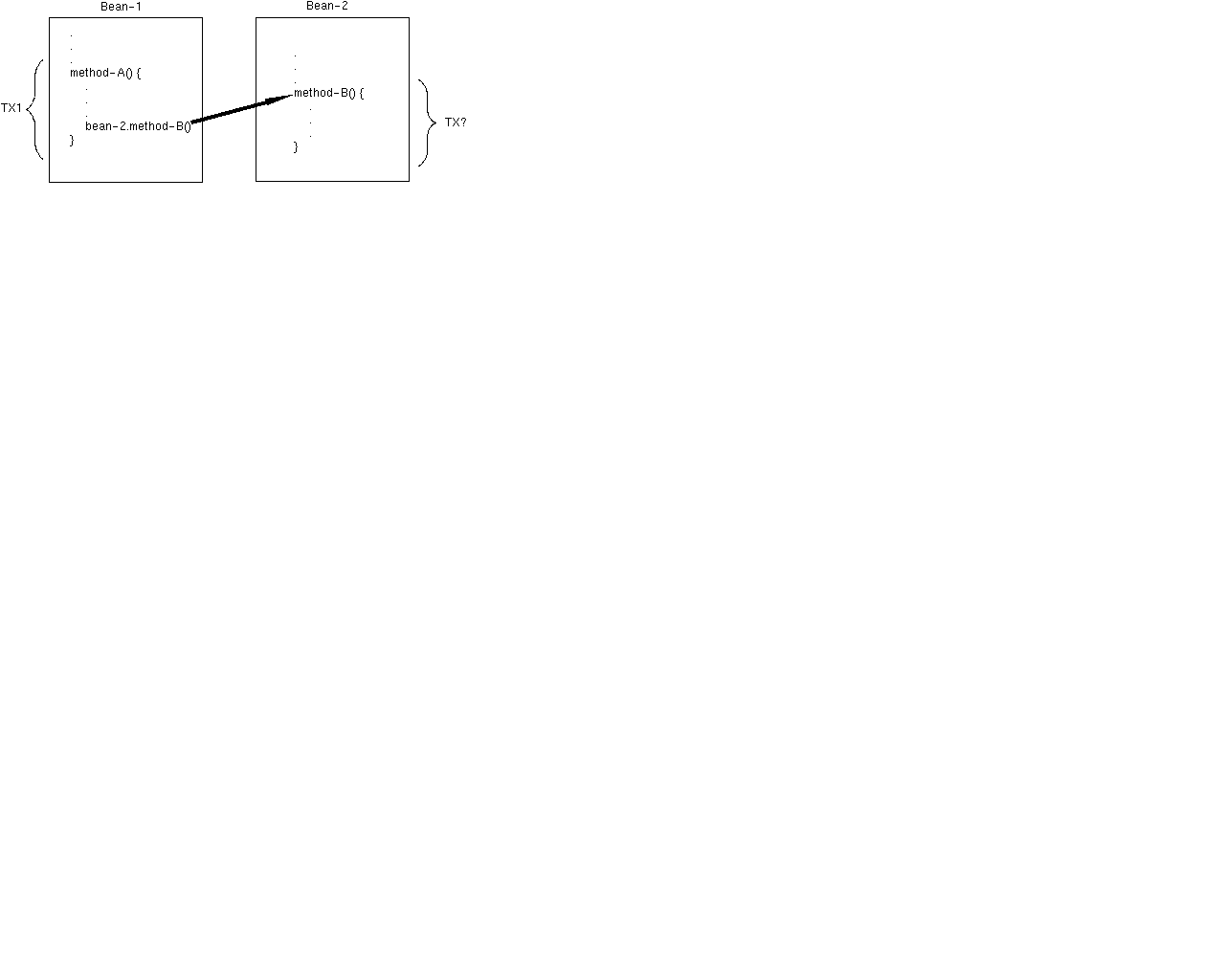
| Prev | Next | J2EETM Developer's Guide
Transactions |
Typically, the container begins a transaction immediately before an enterprise bean method starts. It commits the transaction just before the method exits. Each method can be associated with a single transaction. Nested or multiple transactions are not allowed within a method.
Container-managed transactions do not require all methods to be associated with transactions. When deploying a bean, you specify which of the bean's methods are associated with transactions by setting the transaction attributes.
The Required attribute will work for most transactions. Therefore, you may want to use it as a default, at least in the early phases of development. Because transaction attributes are declarative, you can easily change them at a later time.
You should use the RequiresNew attribute when you want to ensure that the method always runs within a new transaction.
TransactionRequiredException.
Use the Mandatory attribute if the enterprise bean's method must use the transaction of the client.
If the client is not associated with a transaction, the container does not start a new transaction before running the method.
Use the NotSupported attribute when you want to ensure that the method will never run within a transaction generated by the container.
Because the transactional behavior of the method may vary, you should use the Supports attribute with caution.
RemoteException. If the client is not associated with a transaction, the container does not start a new transaction before running the method.
In the last column, the word "none" means that the business method does not execute within a transaction controlled by the container. However, the database calls in such a business method might be controlled by the transaction manager of the DBMS.
You can specify the transaction attributes for the entire enterprise bean or for individual methods. If you've specified one attribute for a method and another for the bean, the attribute for the method takes precedence. When specifying attributes for individual methods, the requirements for session and entity beans vary. Session beans need the attributes defined for business methods, but do not allow them for the create methods. Entity beans require transaction attributes for the business, create, remove, and finder methods.
setRollbackOnly method of the EJBContext interface, the bean method instructs the container to roll back the transaction. If the bean throws an application exception, the roll back is not automatic, but may be initiated by a call to setRollbackOnly. (See the section "Handling Exceptions" for a description of system and application exceptions.)
The transferToSaving method of the BankEJB example illustrates the setRollbackOnly method. If a negative checking balance occurs, transferToSaving invokes setRollBackOnly and throws an application exception (InsufficientBalanceException). The updateChecking and updateSaving methods update database tables. If the updates fail, these methods throw a SQLException and the transferToSaving method throws an EJBException. Because the EJBException is a system exception, it causes the container to automatically roll back the transaction. Here is the code for the transferToSaving method:
public void transferToSaving(double amount) throws
InsufficientBalanceException {
checkingBalance -= amount;
savingBalance += amount;
try {
updateChecking(checkingBalance);
if (checkingBalance < 0.00) {
context.setRollbackOnly();
throw new InsufficientBalanceException();
}
updateSaving(savingBalance);
} catch (SQLException ex) {
throw new EJBException
("Transaction failed due to SQLException: "
+ ex.getMessage());
}
}
When the container rolls back a transaction, it always undoes the changes to data made by SQL calls within the transaction. However, only in entity beans will the container undo changes made to instance variables. (It does so by automatically invoking the entity bean's ejbLoad method, which loads the instance variables from the database.) When a rollback occurs, a session bean must explicitly reset any instance variables changed within the transaction. The easiest way to reset a session bean's instance variables is by implementing the SessionSynchonization interface.
SessionSynchonization interface, which is optional, allows you to synchronize the instance variables with their corresponding values in the database. The container invokes the SessionSynchonization methods-- afterBegin, beforeCompletion, and afterCompletion-- at each of the main stages of a transaction.
The afterBegin method informs the instance that a new transaction has begun. The container invokes afterBegin immediately before it invokes the business method. The afterBegin method is a good place to load the instance variables from the database. The BankEJB class, for example, loads the checkingBalance and savingBalance variables in the afterBegin method:
public void afterBegin() {
System.out.println("afterBegin()");
try {
checkingBalance = selectChecking();
savingBalance = selectSaving();
} catch (SQLException ex) {
throw new EJBException("afterBegin Exception: " +
ex.getMessage());
}
}
The container invokes the beforeCompletion method after the business method has finished, but just before the transaction commits. The beforeCompletion method is the last opportunity for the session bean to roll back the transaction (by calling setRollbackOnly). If it hasn't already updated the database with the values of the instance variables, the session bean may do so in the beforeCompletion method.
The afterCompletion method indicates that the transaction has completed. It has a single boolean parameter, whose value is true if the transaction was committed and false if it was rolled back. If a rollback occurred, the session bean can refresh its instance variables from the database in the afterCompletion method:
public void afterCompletion(boolean committed) {
System.out.println("afterCompletion: " + committed);
if (committed == false) {
try {
checkingBalance = selectChecking();
savingBalance = selectSaving();
} catch (SQLException ex) {
throw new EJBException("afterCompletion SQLException: " +
ex.getMessage());
}
}
}
commit, setAutoCommit, and rollback methods of java.sql.Connection getUserTransaction method of javax.ejb.EJBContextjavax.transaction.UserTransaction